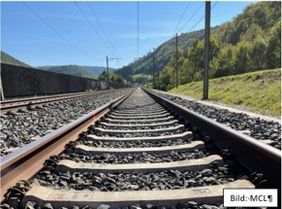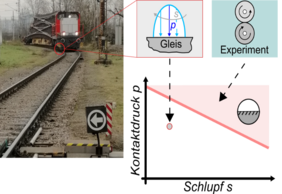Hundreds of millions of Euros in Austria and billions of Euros in the European Union are lost due to damage and the resulting operational disruptions in the rail system. The starting point of such damage is usually the highly stressed contact area between the wheel and the rail. The forces between vehicle wheels and rails cause extreme contact stresses. This stress can be compared to a 40-ton truck parked on four 10 cent coins. These forces cause local deformation of the contact zone between wheel and rail, which is inevitably damaged by the many millions of wheels passes over the course of time. The damage behavior of wheels and rails is determined by their material properties, the dynamics of the vehicles and the vibration behavior of the ground. In addition to material loss on the contact surfaces, cracks can also form. For safety reasons, rails and wheels are therefore regularly maintained and, depending on the type and extent of any damage, re-profiled or replaced.
The damage mechanisms in the contact area are referred to wear and rolling contact fatigue. Both mechanisms effect the driving safety, the traveling comfort and cause high costs due to maintenance measures and interruptions of operation during maintenance or when rails are replaced.
Cost reduction but keeping high quality
The most effective way to reduce costs while keeping comfort and safety at least constant is the knowledge-based, material-dependent prediction of damage occurrence and damage development as well as the development of measures to minimize or avoid damage. For this purpose, not only numerical models but also new experiments were designed at the Materials Center Leoben to predict the different damage mechanisms. The development of the numerical models was challenging and turned out to be extremely complex, because it is a multiscale problem in the range of meters to nanometers. Furthermore, it involves a combination of nonlinearities from contact mechanics and material description. Additionally, the model verification of the complex loading of the materials occurring in the wheel-rail contact area could not simply be performed with standard tests. Therefore, special specimen geometries were developed at the Materials Center Leoben, with which the damage evolution under wheel-rail contact conditions can be reproduced.
Impact and effects
The new experimental results are used in the models developed specifically for railway systems and allow the quantitative prediction of damage development. This enables rail operators to evaluate wear, crack initiation and crack growth in different areas of the track (straight lines, curves, station entrances and exits) based on the trains running on them. Rail and wheel manufacturers thus have the opportunity to use and evaluate new or improved materials in terms of their damage behavior.
Project coordination (Story)
Georg Schnalzger
Junior Scientist Computational Product Reliability
Materials Center Leoben Forschung GmbH
T +43 (0) 3842 45922-0
georg.schnalzger(at)mcl.at
Project partners
• voestalpine Railway Systems GmbH, Austria
• The University of Sheffield, United Kingdom
• Austrian Academy of Sciences, Austria
• Montanuniversität Leoben




















